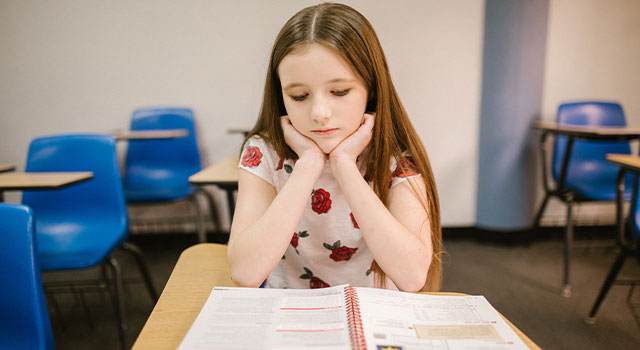 Reading involves the simultaneous coordination of a number of basic visual skills. For children who have not yet mastered some of these skills, reading can be an exercise in frustration, leading them to avoid reading altogether.
Reading involves the simultaneous coordination of a number of basic visual skills. For children who have not yet mastered some of these skills, reading can be an exercise in frustration, leading them to avoid reading altogether.
While many of us take our eyes’ ability to converge, focus and track for granted, those with underdeveloped visual skills often struggle to keep track of where they are on the page and to fully understand and remember what they've just read.
We’ve outlined four of the top vision-related reasons why children refuse to read, and how vision therapy can help your child become a more confident reader.
1. Eye Tracking Problems
Eye tracking is the eyes' ability to move smoothly and accurately from place to place. Good eye tracking skills allow a child to keep their eyes on an incoming baseball or move successfully from word to word on a page of text without losing their place.
For a child with eye-tracking issues, eye movements will be slow and inaccurate, often seen as eye flickering or requiring extra head movements, to compensate for the reduced visual skill.
Poor eye tracking can cause a child to frequently lose their spot and skip words or even whole lines of text while reading. In this case, the child uses a lot more energy than their peers to simply keep track of where they are on the page, causing difficulty with reading comprehension and fluency.
2. Difficulties With Eye Teaming
Eye teaming is the eyes’ ability to work together to send accurate visual information to the brain. Although each eye sends a slightly different image, the brain is able to combine these two images into a single picture, allowing for three-dimensional vision and depth perception.
When children have problems with eye teaming, their eyes are unable to work together. They send two very distinct images to the brain, which struggles to easily combine the two images into a single clear, cohesive image.
A child attempting to read with eye teaming issues may experience eye strain, headaches or even double vision. Often, words on a page will look blurry or appear to ‘float’ on the page. Eye teaming difficulties may also cause the child to have a reduced attention span, and lead them to avoid reading or not read at grade level.
3. Visualization Problems
Visualization refers to the ability to see something in the mind’s eye even if that thing is not right there in front of us. This skill allows a child to recall words and remember how to spell words that they’ve previously seen. Visualization allows many of us to read a story and then ‘see’ the characters and events play through our mind as if we are watching a film.
For some children, however, this doesn’t happen. The brain has a hard time taking the visual information it’s receiving from the eyes and interpreting it into larger images and concepts. This can result in poor reading comprehension and may render that reading is a chore and an unenjoyable experience.
4. Issues with Accommodation
Accommodation is the ability to refocus the eyes each time we shift our gaze from one image or object to the next. This happens as a result of the swift and accurate contraction and relaxation of muscles in the eye to quickly focus and refocus as the eye moves.
In children with accommodation problems, the focusing muscles in the eyes do not smoothly contract and relax efficiently as their eyes move across the page from word to word or from a book (or screen) to the board and back. They need to stop and refocus their vision every time they read another word. This stop-and-start type of reading harms reading comprehension, and the constant need to refocus can cause headaches and eye strain.
So What’s The Solution?
All of the problems mentioned above are due to reduced visual skills and can be frustrating for children and parents alike. Fortunately, there is a solution: vision therapy.
Vision therapy is a personalized, doctor-prescribed evidence-based regimen of in-office and at-home eye exercises to teach your child’s eyes and brain to more effectively work together. Depending on your child’s needs, the customized program may include vision therapy aids such as prism glasses, devices and specialized therapy computer programs.
Contact Silicon Valley Eye Physicians to help your child get back on track with their reading and learning.
Silicon Valley Eye Physicians offers vision therapy to patients from Sunnyvale, Los Altos, Mountain View, and Cupertino, California and surrounding communities.
